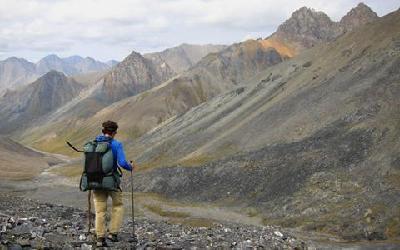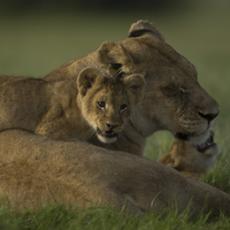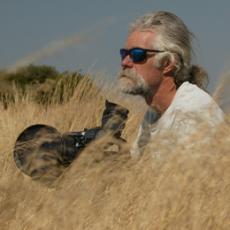
STEVE EMBER: I'm Steve Ember.
BARBARA KLEIN: And I'm Barbara Klein with EXPLORATIONS in VOA Special English. Today on our program we meet an extreme hiker. He recently completed a more than 7,000 kilometer exploration of the state of Alaska and Canada's Yukon territory.
We also travel to the wilderness of southern Africa to learn about some big cats. The movie "The Last Lions" gives viewers an extraordinary look at a mother lion as she struggles to survive and protect her young.
(MUSIC)
STEVE EMBER: Andrew Skurka is an athlete, outdoorsman and writer. But when he goes for a walk outside, it is not your average trip. Mr. Skurka is known for going on hiking trips that last for thousands of kilometers. He walked more than 11,000 kilometers alone through the western United States in 2007. The next year, he hiked more than 800 kilometers to cross Iceland alone.
The 29-year-old has become known among explorers as a very skillful extreme hiker. He is also known for carefully preparing and researching every detail of his trips. A story on his most recent trip was published in this month's National Geographic Magazine.
BARBARA KLEIN: Andrew Skurka spent about six months hiking, skiing and rafting through Alaska and Canada's Yukon Territory. The more than 7,000 kilometer trip lasted from March 14th until September 1st of last year.
It was not an easy trip. Snow covering much of the area was beginning to melt. So it could not support his weight on skis. And it was difficult to walk through the knee-deep snow. Mr. Skurka was not traveling along established paths. He was finding his own way through the complete wilderness of Alaskan "backcountry".
He said the most difficult period of the trip was crossing the Yukon Arctic and the Arctic National Wildlife Refuge in Alaska.
ANDREW SKURKA: "And I went 657 miles, or roughly I guess it's about about 1,100 kilometers and 24 days without seeing another human being and without crossing a road. And it certainly didn't help that during that section I got clobbered by bugs and I was caught by two different floods."
BARBARA KLEIN: But he says the biggest difficulty he struggled with was how huge and wild that area of the world is.
ANDREW SKURKA: "There is something about that stretch that made me feel so much more vulnerable and susceptible and exposed to the natural conditions. And I think a lot of it had to do with knowing that I was so far out there that if anything were to go wrong, help was a long way away"
STEVE EMBER: To succeed on these difficult trips, Andrew Skurka does a great deal of research. He finds out exactly what kind of territory he will be travelling through and what he will need. He uses hundreds of maps to plan his route. And, he does not carry much with him. This way he can move more quickly and is more comfortable as he travels. For example, in summer he carries about ten kilograms of equipment. For the Alaska trip, he planned in advance where he would stop along the way to buy food and supplies so he did not have to carry extra weight.
His diet during his trips includes chocolate candies, nuts, potato chips, cookies, dried beef and energy bars. It is not the most healthful diet, but his aim is to eat as many calories as possible.
ANDREW SKURKA: "I try to eat about 4,500 to 5,500 calories per day. And that is enough for me to avoid losing an excessive amount of weight when I am out there. But it's also enough to keep me sustained. And I'm putting in really long days. I'm moving for 14 to 16 hours a day."
BARBARA KLEIN: Mr. Skurka says that he always loved the outdoors as a child. But he did not think he could make a career out of this interest. After working at a summer camp for two seasons, he realized he did not have to follow his expected career path of working as a financial expert. He decided to make a career out of being an explorer and athlete.
The National Geographic Society helped Mr. Skurka pay for his most recent trip. But he says if that money had not come through, he was ready to raise money through public speaking, guided trips, and his writing.
STEVE EMBER: We asked Mr. Skurka for advice on how beginners can learn to backpack and take long trips outdoors. He says learning to take these trips is a skill and takes work. He says the best way to learn is to read books about backpacking trips, talk to experts and then get outside and start doing it.
Andrew Skurka says he is not sure where his next trip will be. But he says wherever he goes, it will be under intense conditions through big, wild places.
(MUSIC)

BARBARA KLEIN: The film "The Last Lions" takes place in the Okavango Delta of Botswana. Actor Jeremy Irons explains the action in the movie. A lioness named Ma di Tau (mah dee taw) or "Mother of Lions," her mate and three cubs live on the grassy plains. But a group of lions from the north invades and fights them for control of the territory. The father lion is severely wounded and dies.
The lioness must make an important decision if she and her cubs are to survive. She cannot stay and have her cubs killed by the enemy lions. If she travels in one direction, she will find people and villages. And where there are people, there are guns. In another direction, a wildfire is burning the plains. To escape, she chooses to swim across a muddy body of water where crocodiles live.
JEREMY IRONS: "'Til today she had only time to focus on escape and survival but now she must find a way to get her cubs safely through their first critical year until they can fend for themselves. And as a single mother this will take every ounce of her energy and intelligence."
STEVE EMBER: In her new environment on Duba Island, the mother lion must struggle to survive threats from other lions and huge, fierce buffalo. She must also risk leaving her cubs unprotected while she hunts for food.
JEREMY IRONS: "A lion hunt is as much a mind game as it is a physical explosion of violence."
BARBARA KLEIN: "The Last Lions" permits viewers to enter into the world of these creatures. You see how the lioness cares for her young and how she plans to attack the buffalo she needs for food.
The movie was made by husband and wife team Dereck and Beverly Joubert with support from National Geographic Entertainment. The Jouberts have spent 30 years filming and observing lions in the African wild. They have made over 20 movies and written many books and articles about the behavior of animals in the wild.
STEVE EMBER: The Jouberts have lived on Duba Island for seven years. They have had the rare experience of watching a group – or pride -- of lions form and evolve. The couple was able to watch the lions get used to living in new and unusual conditions. They came to know each lion well. Mr. Joubert says they know the individual lions as well as they know their own family members.
The Jouberts lived in a small tent not far from the lions. So they were able to quickly film any action during the day or night. The lions became used to humans nearby. This permitted the filmmakers to capture recordings few humans have seen before. New digital cameras also helped them to record images that would not have been technologically possible in the past.
BARBARA KLEIN: The filmmakers followed many lions, but were especially interested in Ma di Tau and her efforts to survive on her own. Mr. Joubert has said this about watching Ma di Tau: "Her struggle was our struggle, her battles were our battles. Perhaps this is consistent with any study of the natural world."

He says they were able to share with viewers the emotions they experienced while watching the lioness. These include fear, calm, sadness, happiness and courage.
STEVE EMBER: The Jouberts note that lions play a central role in the fairy tales, stories and language of humans. They say lions are part of the human experience. So, their survival is important to humanity.
The film's most important message is about the sad reality that these large cats are slowly disappearing from the wild. The movie notes that in the past 50 years the lion population in the wild has decreased from 450,000 to as few as 20,000. "The Last Lions" shows why it is important to help save these creatures before they disappear from the wild forever.
(MUSIC)
BARBARA KLEIN: This program was written and produced by Dana Demange. I'm Barbara Klein.
STEVE EMBER: And I'm Steve Ember. You can see pictures of Andrew Skurka and "The Last Lions" on our website, voaspecialenglish.com. You can also find a link to the National Geographic's campaign to help save big cats. Join us again next week for EXPLORATIONS in VOA Special English.
Tiger gave birth to 27 cubs in 7 years
Baby girl plays with Sumatran tiger cub
Tigers in wild face risk of extinction
(来源:VOA 编辑:崔旭燕)
